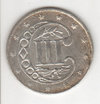|
|
3 Cent Silver
United States three cent coin was a unit of currency equaling 3/100th of a United States dollar. The mint produced two different three cent coins, the three cent silver and the three cent nickel.

History of the 3 Cent Silver
The three cent coin has an unusual history. It was proposed in 1851 both as a result of the decrease in postage rates from five cents to three and to answer the need for a small denomination, easy to handle coin. The three cent silver featured a shield on a six sided star on the obverse and a Roman numeral 'III' on the reverse. The coin was composed of 75% silver and 25% copper to ensure that the coin would be considered real currency yet not worth melting down for the silver (see melt value).
The coins were physically the smallest coins ever minted by the United States. The silver coins were known as "fishscales". The term "trimes" is often used today for these coins but that was first used by the director of the U.S. Mint (James Ross Snowden) at the time of their production.
Starting in 1854, the three cent silver had its silver metal content raised to 90% in order to encourage circulation. The coin went through a design change at the time (three lines to border the star). A final design change occurred in 1859 due to striking problems, the number of lines bordering the star was reduced to two. They had a tendency to discolor rapidly. The three cent silver coin was minted from 1851 to 1873, but the 1873 issue was in proof state only.
 Civil War era silver shortages led to widespread hoarding of all silver coins, and most one and five cent coins as well. Various alternative were tried, including encapsulated postage and privately issued coinage. The Treasury eventually settled on issuing fractional currency. These small denomination (1 to 50 cents) were never popular, as they were easy to lose and unwieldy in large amounts. Civil War era silver shortages led to widespread hoarding of all silver coins, and most one and five cent coins as well. Various alternative were tried, including encapsulated postage and privately issued coinage. The Treasury eventually settled on issuing fractional currency. These small denomination (1 to 50 cents) were never popular, as they were easy to lose and unwieldy in large amounts.
The answer to this issue was reached in 1865 with the introduction of the three cent nickel coin. This coin was composed of copper and nickel and was larger than the silver coin of the same denomination. The coin featured a Liberty head obverse and another Roman Numeral 'III' reverse. The three cent nickel was never intended as a permanent issue, only as stop gap measure until the wartime hoarding ceased. However, production of the coin continued until 1889, 16 years after the three cent silver was discontinued.
|

